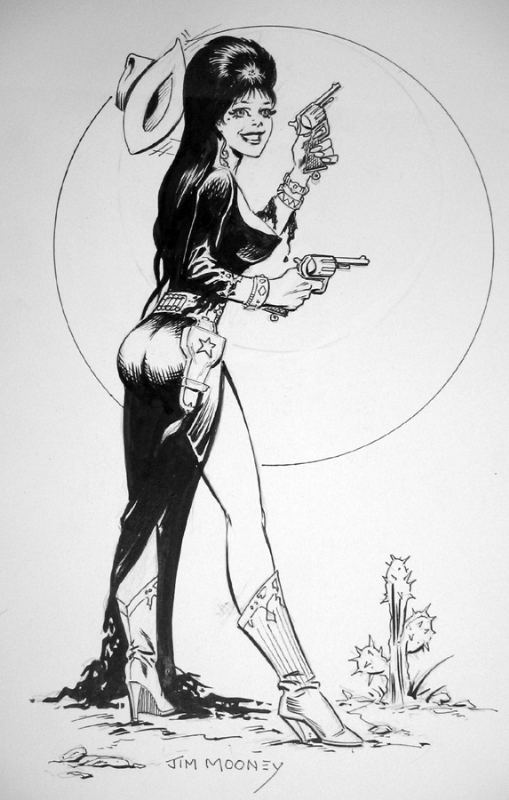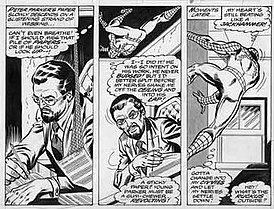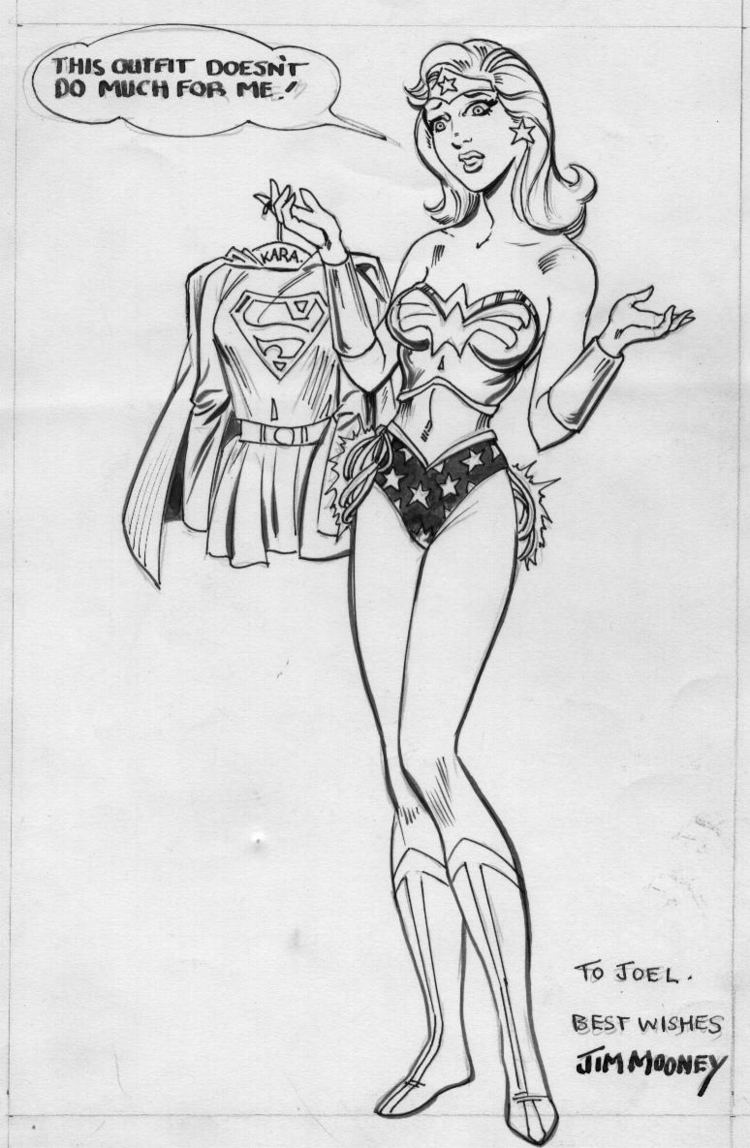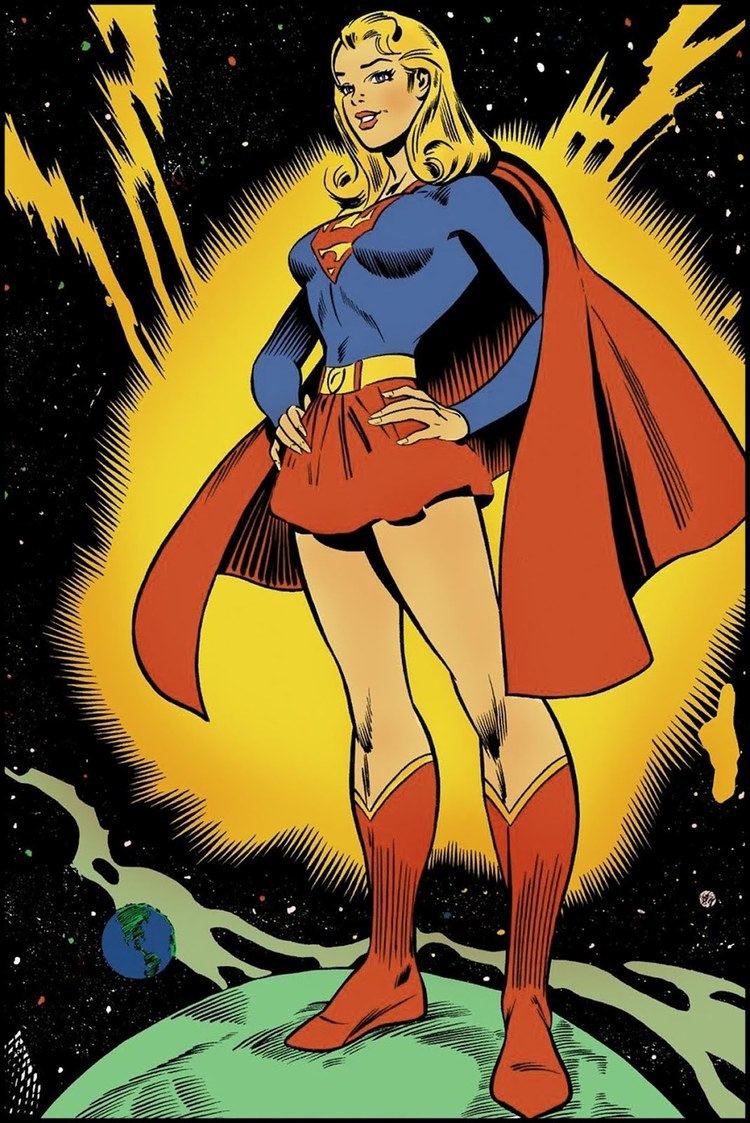Nationality American TV shows Spider-Woman Name Jim Mooney | Pseudonym(s) Jay Noel | |
 | ||
Born August 13, 1919New York City, New York, United States ( 1919-08-13 ) Notable works Died March 30, 2008, Florida, United States Books Essential the Amazing Spider-Man Similar People Sal Buscema, Mike Esposito, John Romita Sr, Gerry Conway, Bill Mantlo | ||
James Noel Mooney (August 13, 1919 – March 30, 2008) was an American comics artist best known for his long tenure at DC Comics and as the signature artist of Supergirl, as well as a Marvel Comics inker and Spider-Man artist, both during what comics historians and fans call the Silver Age of comic books. He sometimes inked under the pseudonym Jay Noel.
Contents

Early life and career

Jim Mooney was born in New York City and raised in Los Angeles. Friends with pulp-fiction author Henry Kuttner and Californian science-fiction fans such as Forrest J. Ackerman, he drew the cover for the first issue of Imagination, an Ackerman fanzine that included Ray Bradbury's first published story, "Hollerbochen's Dilemma". Kuttner encouraged the teenaged Mooney to submit art to Farnsworth Wright, the editor of the pulp magazine for which Kuttner was writing, Weird Tales. Mooney's first professional sale was an illustration for one of Kuttner's stories in that magazine. During this period, Mooney also met future comic-book editors Mort Weisinger and Julius Schwartz, who had come to the area to meet Kuttner.

After attending art school and working as a parking valet and other odd jobs for nightclubs, Mooney went to New York City in 1940 to enter the fledging comic-book field. Following his first assignment, the new feature "The Moth" in Fox Publications' Mystery Men Comics #9-12 (April–July 1940), Mooney worked for the comic-book packager Eisner & Iger, one of the studios that would supply outsourced comics to publishers testing the waters of the new medium. He left voluntarily after two weeks: "I was just absolutely crestfallen when I looked at some of the guys’ work. Lou Fine was working there, Nick Cardy ... and Eisner himself. I was beginning to feel that I was way, way in beyond my depth...."

Mooney went on staff at Fiction House for approximately nine months, working on features including "Camilla" and "Suicide Smith" and becoming friends with colleagues George Tuska, Ruben Moreira, and Cardy. He began freelancing for Timely Comics, the 1940s predecessor of Marvel, working on that company's "animation" line of funny animal and movie-cartoon tie-in comics.

As Mooney describes his being hired by editor-in-chief and art director Stan Lee:

I met Stan the first time when I was looking for work at Timely. . . . I came in, being somewhat young and cocky at the time, and Stan asked me what I did. I said I penciled; he said, 'What else?' I said I inked. He said, 'What else?' I said, 'Color.' 'Do anything else?' I said, 'Yeah, I letter, too.' He said, 'Do you print the damn books, too?' I guess he was about two or three years my junior at that point. I think I was about 21 or 22.

Mooney also wrote and drew a funny-animal feature, "Perky Penguin and Booby Bear", in 1946 and 1947 for Treasure Chest, the Catholic-oriented comic book distributed in parochial schools.
Supergirl and DC

In 1946, Mooney began a 22-year association with the company that would evolve into DC. He began with the series Batman as a ghost artist for credited artist Bob Kane. As Mooney recalled of coming to DC,
[T]he funny animal stuff was no longer in demand, and an awful lot of us were scurrying around looking for work . . . and I heard on the grapevine that they were looking for an artist to do Batman. So I buzzed up there to DC, talked to them and showed them my stuff, and even though they weren't so sure because of my funny-animal background, they gave me a shot at it. I brought the work in, and [editor] Whitney Ellsworth said, 'OK, you're on'. . . . [I]t was ghosting. [Prominent Batman ghost-artist] Dick Sprang [had] taken off and wanted to do something else. So Dick took off for Arizona, and DC was looking for someone to fill in. So, that's where I fit in, and I stayed on Batman for quite a few years. . . .
Writer Bill Finger and Mooney introduced the Catman character in Detective Comics #311 (Jan. 1963). Mooney branched out to the series Superboy, and such features as "Dial H for Hero" in House of Mystery, and Tommy Tomorrow in both Action Comics and World's Finest Comics. He also contributed to Atlas Comics, the 1950s iteration of Marvel, on at least a handful of 1953-54 issues of Lorna the Jungle Queen.
Most notably, Mooney drew the backup feature "Supergirl" in Action Comics from 1959 to 1968. For much of this run on his signature character, Mooney lived in Los Angeles, managing an antiquarian book store on Hollywood Boulevard and sometimes hiring art students to work in the store and ink backgrounds on his pencilled pages. By 1968, he had moved back to New York, where DC, he recalled, was
... getting into the illustrative type of art then, primarily Neal Adams, and they wanted to go in that direction. Towards the end there I picked up on it and I think my later 'Supergirl' was quite illustrative, but not quite what they wanted. I knew the handwriting was on the wall, so I was looking around.... The reason I hadn't worked at Marvel for all those years was because they didn't pay as well as DC. ... I think at that time [it] was $30 [a page] when I was getting closer to $50 at DC".
Spider-Man and Marvel
By now, however, the rates were closer, and Mooney left DC. Marvel editor Stan Lee had him work with The Amazing Spider-Man penciler John Romita. Mooney first worked on Spider-Man by inking The Spectacular Spider-Man magazine's two issues. Mooney would go on to ink a run of Amazing Spider-Man (#65, 67-88; Oct. 1968, Dec. 1968 - Sept. 1970), which he recalled as "finalising it over John’s layouts". Among the new characters introduced during Mooney's run on the title were Randy Robertson as a member of the supporting cast in issue #67 (Dec. 1968) and the Prowler in #78 (Nov. 1969). Mooney also embellished John Buscema's pencils on many issues of The Mighty Thor.
As a penciler, Mooney did several issues of Peter Parker, the Spectacular Spider-Man, as well as Spider-Man stories in Marvel Team-Up, and he both penciled and inked issues of writer Steve Gerber's Man-Thing and the entire 10-issue run of Gerber's cult-hit Omega the Unknown, among many other titles. Mooney named his collaborations with Gerber as being among his personal favorites. In 2010, Comics Bulletin ranked Gerber and Mooney's run on Omega the Unknown tenth on its list of the "Top 10 1970s Marvels". Carrion debuted in The Spectacular Spider-Man #25 (Dec. 1978) by Bill Mantlo and Mooney. Writer Ralph Macchio and Mooney introduced the Rapier in The Spectacular Spider-Man Annual #2 (1980).
Mooney also worked on Marvel-related coloring books, for the child-oriented Spidey Super Stories, and for a Spider-Man feature in a children's-magazine spin-off of the PBS educational series The Electric Company, which included segments featuring Spider-Man. On the other end of the spectrum, he drew in the late 1960s and early 1970s for Marvel publisher Martin Goodman's bawdy men's-adventure magazine comics feature "The Adventures of Pussycat": "Stan [Lee] wrote the first one I did, and then his brother Larry [Lieber] wrote the ones that came later".
In 1975, Mooney, wanting to move to Florida, negotiated a 10-year contract with Marvel to supply artwork from there. "It was a good deal. The money wasn't too great, but I was paid every couple of weeks, I had insurance, and I had a lot of security that most freelancers never had". That same year, Mooney and his wife, Anne, had a daughter, Nolle.
Later life and career
In Florida, Mooney co-created Adventure Publications' Star Rangers with writer Mark Ellis, and worked on Superboy for DC Comics, Anne Rice's The Mummy for Millennium Publications, and the Creepy miniseries for Harris Comics. When Harris editor Richard Howell left to co-found Claypool Comics in 1993, Mooney produced many stories for the 166-issue run of Elvira, Mistress of the Dark and became the regular inker on writer Peter David's Soulsearchers and Company, over the pencils of Amanda Conner, Neil Vokes, John Heebink, and mostly Dave Cockrum. Mooney also inked four covers of Howell's Deadbeats series. Mooney's other later work included the sole issue of writer Mark Evanier's Flaxen, over Howell pencils; a retro "Lady Supreme" story for Awesome Entertainment; and commissioned pieces. In 1996, Mooney was one of the many creators who contributed to the Superman: The Wedding Album one-shot wherein the title character married Lois Lane.
Mooney's wife Anne died in 2005. Mooney died March 30, 2008 in Florida after an extended illness.
